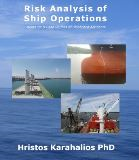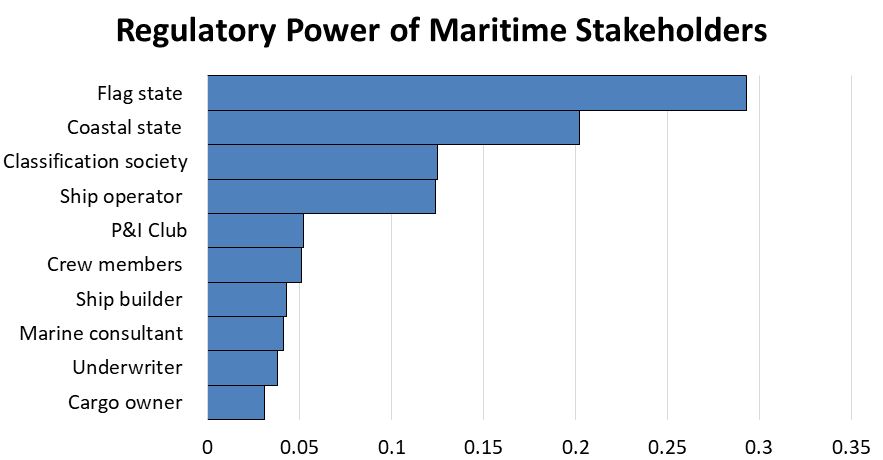A proposed System of Hierarchical Scorecards to assess the implementation of maritime regulations
H. Karahalios, Z.L. Yang, V. Williams, J. Wang
Liverpool Logistics, Offshore and Marine (LOOM) Research Institute, School of Engineering, Technology and Maritime Operations, Liverpool John Moores University, Liverpool, Merseyside, L3 3AF, UK
Abstract
The successful implementation of a regulation in the modern complicated world is a major issue for states. A newly introduced regulation may cause conflicts of interest among various parties that are affected. A common conflict is that from one hand, the public demands the introduction of regulations that will increase safety, environmental and security standards while on the other hand industries are concerned about potential costs caused by new regulations. In this paper, the shipping industry, which is a typical example of an international industry, is chosen to carry out a cost and benefit analysis generated from the implementation of a newly introduced regulation. Consequently, a methodology is proposed
capable of evaluating the implementation performance of a regulation in the shipping industry with respect to the costs and benefits that can be generated. For a simple and effective computation, a System of Hierarchical Scorecards (SHS) is developed to assist regulators in evaluating any proposed and/or existing regulations.
2010 Elsevier Ltd. All rights reserved.
Keywords:
Maritime regulations, Balanced scorecard, Regulation implementation, Marine stakeholders, Fuzzy sets, AHP, Regulation appraisal
1. Introduction
The development of an appropriate framework of regulating safety at sea is an issue, which, due to its importance, is governed by a variety of international conventions introduced by the International Maritime Organisation (IMO). The IMO succeeded in producing a high number of conventions, codes and circulars, which are referred in this paper as the ‘‘Maritime Regulations’’. However, the implementation of the maritime regulations in many geographical regions is slow and inadequate (Lambrou et al., 2008; Sampson and Bloor, 2007; McMahon, 2007; Llacer, 2003). A main result of this inadequate implementation is the existence of a multiform regulatory regime. Many ship operators found the opportunity of operating their ships in substandard conditions.
Furthermore, many private organisations of the shipping industry found themselves in an uncomfortable position while developing their business in such a regulatory regime (Neser et al., 2008; Klikauer and Morris, 2003). To achieve a uniform regime the IMO developed a strategic plan (IMO, 2004) and introduced the Formal Safety Assessment (FSA) tool to address the quality aspect of a maritime regulation (Ruuda and Mikkelsen, 2008; Wang, 2006). Many academics have found the maritime regulations to be an interesting research field. Such research has focused on safety at sea, pollution from shipboard operations, the performance and analysis of various ship related operations, by means of such tools as the FSA and the International Management Code for the Safe Operation of Ships and for Pollution Prevention, referred to as the ISM code. To date no academic or industrial organisation has offered a method capable of dealing with the worldwide implementation of maritime regulations. Moreover, there is only limited research directed at strategies or methodologies designed to improve the implementation of the maritime regulations. Nevertheless, there is debate that a worldwide implementation could be easily achieved if the stakeholders in the shipping industry had an increased role in the regulatory process (Chantelauve, 2003). In this paper the word implementation was chosen to describe the primary stages of successful enforcement of a regulation. It is also suggested that a world-wide implemented regulation would be more easily enforced provided that appropriate stakeholders will endeavor to this direction. Furthermore an attempt to investigate enforcement of a regulation may include parameters such as safety culture that may apply to different states and may not be measurable.
In this paper, a new methodology is presented with regard to the implementation of a maritime regulation. The proposed methodology is developed to address the need of a new strategy targeting the effective implementation of a maritime regulation. The strategy is based on the assumption that some stakeholders, who are defined in this paper as any group of persons or companies with interest in the shipping industry, could fail to implement a regulation due to lack of resources. Such resources may include lack of knowledge, inadequate access to technologies, and lack of human recourses. Furthermore a stakeholder may choose to disregard a regulation because he cannot identify and/or evaluate the long term benefits that he may achieve by implementing that particular regulation.
The new strategy will be based on the evaluation of an existing and/or a newly introduced maritime regulation implementation performance through a cost benefit analysis for all the relevant stakeholders. By adopting this approach it will be possible to evaluate the potential cost that a stakeholder may suffer due to the implementation of a regulation. Additionally the competitive advantages that a stakeholder may gain can also be identified and evaluated. The advantage of this approach is that the evaluation of costs and benefits of a regulation can be achieved and consequently make easier a direct comparison among them. Such an approach can be adopted by introducing a methodology the applicability of which is demonstrated by the means of a numerical example.
2. Background
2.1. Major problems in the implementation of the maritime regulations
A thorough literature review was conducted in order to investigate the existing options for improving the implementation of the maritime regulations. The result indicates that the current regulatory system would be more effective if there was a stricter process of monitoring its implementation progress. Options such as a selfregulation approach may not be applicable for the shipping industry mainly due to variation of seamen skills, lack of appropriate training (Vanem et al., 2008; Hetherington et al., 2006; Klikauer and Morris, 2003) and the vague sense of safety standards between the stakeholders (Neser et al., 2008; Goss, 2008; Bennett, 2000). Moreover, many academics suggest that the stakeholders could increase safety standards at sea by supporting the existing regulatory status (Lambrou et al., 2008; Chantelauve, 2003). The introduction of more regulations may increase the cost of the stakeholders’ commercial activities and make the operation of the shipping industry more complicated (Li and Cullinane, 2003). Consequently, the stakeholders’ interest in contributing positively to the regulatory process depends on the benefits that they can gain against the costs they should afford. It should be noted that many of the stakeholders such as insurers and cargo owners are not bound by the IMO conventions.
2.2. An alternative approach to improve a worldwide implementation of regulations
Up to date the only methodology that was developed targeting the improvement of maritime regulations was the FSA. In the FSA methodology, the costs and benefits that may be generated by a regulation are addressed in a partial and very generic way. For instance, Vanem et al. (2008) noted that in FSA studies, the costeffectiveness criteria do not take any particular stakeholders’ view, and they are not concerned who would have to pay for implementation of risk control options. Therefore, it is necessary and desirable to adopt an additional methodology capable of evaluating the commercial impacts of the implementation of a newly introduced regulation in the shipping industry such as profit, competitiveness, human resources and internal process. In this work, it is argued that there is a possibility of a regulation being scientifically sound but creating an excessive burden for some stakeholders.
The current regulatory system poses a regulatory authority level among the stakeholders (Korte et al., 2002). The authority and power that stakeholders can force other stakeholders with regard to the regulatory process is a key issue in this research in order to assess their weighting in regulatory process. However, this authority and power may sometimes not strong enough especially in periods of economic depression. Therefore it is suggested that the effective worldwide implementation of a regulation greatly depends on the interest of the stakeholders in supporting a maritime regulation by removing possible barriers. Otherwise, some private stakeholders will seek states with lax regulatory regimes in order to run their business. Therefore, a newly introduced regulation should be designed on the basis that will not overburden a small group of stakeholders. In addition, it should also neither restrict nor inhibit a stakeholder from being either innovative or excelling in his business. It should be stressed that in the context of this paper neither innovation nor excelling in business includes practices against health and safety of people or damage to the environment. Both issues can be addressed by developing a strategy that focuses on the following targets:
1. Monitoring the regulation implementation performance of the industry.
2. Monitoring the regulation implementation performance of each stakeholder.
3. Provide a self-assessment tool to a stakeholder with regard to his implementation performance.
Every maritime regulation was introduced by the IMO to enhance safety at sea and/or to protect the environment. The scope of the IMO regulations is twofold to increase safety at sea and minimize pollution from ships (IMO, 2004). A primary scope of such a regime is to increase the safety standards of ships and consequently improve the working environment for seamen and other workers of the industry. A further aim of the IMO regulations is to protect marine environment by introducing pollution prevention measures for ships. Such measures contribute to the overall reduction of risks encountered by populations in many coastal areas. Therefore it is believed that the majority of maritime regulations are linked to safety and health of people and this research falls into the scope of safety science.
Any failure to effectively implement a maritime regulation may have adverse effect in terms of safety, pollution and business damage for the violated party. Consequently, all the requirements of a regulation should be completely implemented since partial implementation
of a regulation may generate grounds for possible accidents. Therefore, the targets of the strategy should always be assessed until they reach as near as possible to be perfect. Otherwise, if the targets are very hard to be achieved, it may be an indication that some of the regulation requirements need to be revised. To meet the second and the third target of the proposed strategy a list of significant items should be gradually followed by any stakeholder in order to achieve effective implementation. This list should include fundamental issues for a company such as implementation procedures, cost assessment, availability of resources and monitoring. Moreover, there is much evidence that accidents are more likely to result from deficiencies of management systems (ABS, 2005). It should be stressed that stakeholders in the shipping industry have different needs and goals. A successful strategy should be able to identify and evaluate those needs. As it is argued in this paper the excessive burden that some stakeholders suffer due to a regulation could have a negative effect to its implementation.
A combination of the Balanced Scorecard (BSC), the Analytical Hierarchy Process (AHP) and the fuzzy set theory, which are separately presented in the sections below, are proposed as anappropriate methodology of effectively implementing maritime regulations. The BSC provides the strategic framework that can be followed to obtain a desired result by producing scorecards. Industrial experts will test the validity of the Balanced Scorecards (BSCs) by using the fuzzy set theory. The AHP can then be used to determine the weight of each BSC element in the implementation process.
2.2.1. Balanced Scorecard
The shipping industry involves many stakeholders with different interests. However there are some common principles such as costs, competitiveness, human resources, known how and workload that could easily be identified to each one. The BSC is a method that covers such principals and therefore has been widely accepted to evaluate the business performance of a company. Kaplan and Norton (1996a,b) introduced the BSC to assist companies in improving their performance by measuring and evaluating their strategies. A company may use the BSC to achieve its goals by monitoring multiple perspectives at the same time. The BSC approach has recently been used by many companies to monitor their regulatory compliance (Stevens, 2006; Huang, 2007; Garcıa-Valderrama et al., 2008; Pedersen and Neergaard, 2008; Osmundsen et al., 2008). It has also been employed as an alternative option to existing total quality management systems such as those proposed by the International Standard Organisation (ISO) (Watkins and Arrington, 2007; Wagner, 2007). Additionally many governments and administrations have used the BSC for monitoring various regulatory issues or their overall performance (Phillips and Phillips, 2007; Ramos et al., 2007; Farneti and Guthrie, 2008; Lee, 2008). Therefore, the BSC is adopted in this paper as a strategic tool capable of monitoring the regulatory performance of the shipping industry.
The first and most important step in designing a BSC is to establish a goal, which identifies the targets of a company. Then the managers of the company should choose the appropriate perspectives, which indicate how to achieve the established goal. Certain measures are required to define and monitor the perspectives. According to the BSC method four performance perspectives can be identified as: (a) financial, (b) learning and growth, (c) customer and (d) internal business (Kaplan and Norton, 1996a,b). Using the scorecard as a strategic monitoring tool, the weakness of a company to achieve the desired goal can be measured and improved. Some researchers who use the BSC suggest that each department
of a company should have its own BSC (Kaplan and Norton, 2005), (Mearns and Havold, 2003). The reason for using many cascade BSCs is that in the modern complex business world the strategy of a company should be shared among its employees in all levels. Therefore, a company should design many BSCs in a cascade format for all its departments from the top to the bottom levels
6. Conclusion
The maritime regulation implementation is a complicated issue mainly due to the large size of the international shipping industry and the large amount of money involved. In this paper, a new methodology was presented capable of evaluating the implementation performance of a maritime regulation. It was proposed that a maritime regulation will be more successfully implemented if there is a balance of costs and benefits between the stakeholders of the industry. Such a balance will increase the interest of stakeholders to implement a regulation and help them to avoid seeking protection from more lax regimes. Additionally, the methodology was developed to address essential issues of the modern shipping industry such as the international characteristics of the industry and the large size of stakeholders involved. Finally, a major issue being dealt with was the market forces, which affect the industry and its development to a high degree. In this paper a system of BSCs that includes the commercial activities of every stakeholder is proposed. This system is designedto identify perspectives and measures that describe the operational activities of each main stakeholder of the shipping industry. A survey where industrial experts participated shows that the proposed
perspectives and measures are applicable to evaluate a maritime regulation and include significant aspects of a cost benefit analysis. The degree of contribution of each stakeholder to the regulation implementation is estimated by using experts’ judgments. The degree of each stakeholder’s contribution is determined through a survey where the industrial experts compare ten main stakeholders in pairs in terms of their contribution to the current regulatory
process. Each stakeholder’s weighting is calculated by using an AHP. The result of ranking stakeholders shows the primary role of the states in the implementation of a regulation. On the other hand the significance of the private stakeholders indicates that a maritime regulation can be implemented more easily if they contribute positively. A notable finding is that the crew members have a very low weight in the implementation process although they are
the people that will be affected significantly.
The experts’ judgements from the survey are evaluated by using Fuzzy Set theory. Each expert in the survey is required to provide his judgements by using nine predefined linguistic terms. Additionally, the experts are required to define the triangular fuzzy set of each linguistic term. From this process, a scale of nine fuzzy numbers is revealed from the survey and it can be used to calculate the weighting of each stakeholder.
The applicability of the proposed tool is demonstrated through a case study. An important indication from the case study is that the correspondent experts believe that the implementation of a regulation may increase the cost of the stakeholders’ commercial activities and make the operation of the shipping industry more complicated. Consequently the stakeholders that suffer most of the burdens from a newly introduced maritime regulation may try to postpone its implementation. Therefore, the regulators should target a fair balance of commercial costs and benefits in order to facilitate the implementation process. A further conclusion that comes from the survey is that the BSC can be used in the shipping industry as a tool capable of evaluating the implementation costs of a maritime regulation to commercial
activities of a stakeholder. The BSCs can be applicable to a variety of stakeholders with different structures and needs. This paper discusses the concept of the severity that a maritime regulation may create to some stakeholders and their activities. The weightings of the perspectives calculated from the survey indicate that some commercial activities are of vital importance for a stakeholder. Consequently, a maritime regulation may cause a severe
impact to a stakeholder if its implementation has a negative effect to these commercial activities.
.


